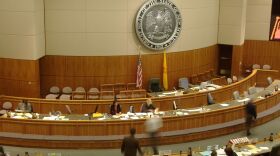Advocates have tried since 2011 to pass a bill that would create a new breed of mid-level dental care providers in New Mexico. It passed the state’s House of Representatives on Monday for the first time ever on a bipartisan vote. If the Senate gives it a thumb’s up before the session ends on Saturday at noon, it could mean a big change for dentistry.
At Cochiti Pueblo’s dental clinic Dr. PatricioLarragoite congratulated his young patient on the lack of buildup on his teeth. "What we’re doing is a teeth cleaning for this young man, part of our prevention program," he said. "I see a baby tooth that’s loose right there. You can come and look at this also, mom."
The patient sat under a bright light in the well-equipped, sunny building. Larragoite wiggled a couple of the kid’s molars, and promised they’ll be out by his birthday in a couple of weeks. The patient promised they’ll be out by that night. "I shouldn’t have told you anything," Larragoite laughed. "You going to put it under your pillow? Does the tooth fairy go to your house? I get half."
Larragoite has been a licensed dentist in New Mexico for 38 years. For much of that time he ran a private office in Santa Fe. Folks would come to him from miles away, he said, because he was one of the few dentists in the area who accepted Medicaid. "You’d see, you know, the little, you know, pickup truck pull into the parking lot. The whole family’s there—grandma, grandpa, kids, mostly a lot of kids—and what they’re doing, they’re maximizing their trip. Because typically they have to travel 60 miles or more one way."
He saw a need, he said, and that’s why he started working in federally qualified health clinics throughout rural New Mexico. A lot of times, a person’s first access to the health care system in New Mexico is a dental encounter, he said. "The mouth is a window to your health, so a lot of things show up first in your mouth. For example, now with the measles epidemics, we do know that there’s small white vesicles that show up in your mouth before you actually have 104 fever and before the red measles show up on your skin."
Larragoite will see 18 patients on this day. That’s his average. And if he had a dental therapist to help him out, he estimated the clinic could see five times as many people.
But dental therapists don’t exist—yet.
Pamela Blackwell of Health Action New Mexico has been pushing for the Legislature to create a mid-level dental provider for five years. So what could a dental therapist do? Routine procedures, like basic fillings, denture repair, and teeth extractions when no incision is required. "This would really help with our underserved areas, which are rural, tribal, and right here in Albuquerque," she said. "You could live next to a dentist, but that does not mean that you’ll get access to dental care."
Less than half of licensed dentists in the state treat Medicaid patients, Blackwell said, and the Affordable Care Act added thousands to the roster of people who can get dental care covered by Medicaid. "In order to make good on the insurance they now have, they need somewhere to go," she said.
Of New Mexico’s 33 counties, 32 are federally designated dentistry shortage areas. Dental therapists would come from the communities dealing with health care shortages, and the idea is that after three or four years of school, they could return home and get to work.
But not everyone is thrilled at the prospect of a new mid-level dental care provider. In fact, the New Mexico Dental Association objects to the bill. Tom Schripsema is the organization's governmental affairs chair. "I do think there’s a possibility that some communities that probably would like to have a dentist," he said, "if they get a dental therapist who’s only got a very limited scope of things that they’re doing, dentists are going to be less likely to locate in those locations later on."
People in rural areas are typically only an hour to an hour-and-a-half away from dental care, he added, and they’re used to traveling into bigger towns to have some of their needs met. "There’s a limited number of financial resources, and we feel like they need to be applied to the solutions that are going to be most effective in solving the problem."
Schripsema said the dental association would rather see dentists paid fairly under Medicaid. He adds that if funding is diverted from dentistry programs to dental therapy programs—or if overreaching changes are made to dentistry regulations—the association will be forced to push back.
***
Public Health New Mexico intern Arianna Sena also contributed to this report. KUNM’s Public Health New Mexico project is funded by the W.K. Kellogg Foundation. Check back in at publichealthnm.org next week for updates on how public health bills fared in the 2015 legislative session.





